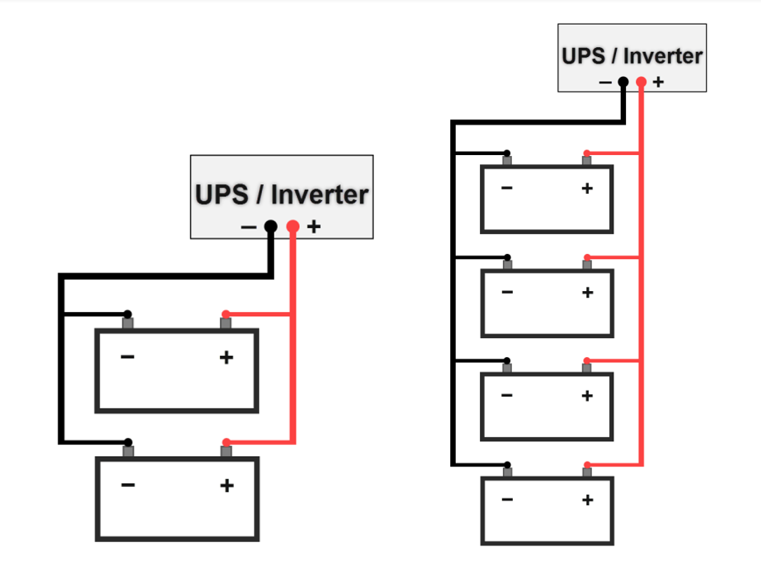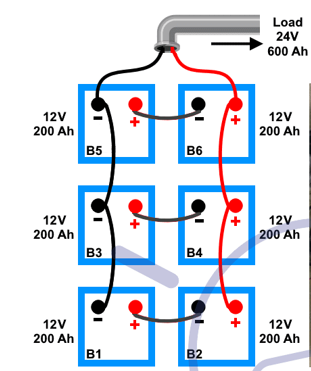Understanding how to connect batteries or which is the correct configuration for charging and storage of a battery bank systems
Three basic types of batteries connections:
- Series Connection
- Parallel Connection
- Series-Parallel Connection
1.1 Series Connection of Batteries
If we connect the positive (+) terminal of battery to negative (-) and negative to positive terminal as shown in the below fig, then the batteries configuration would be in series.

Good to know:
In series connection of batteries, current is same in each wire or section while voltage is different i.e. voltages are additive e.g.
V1 + V2 + V3….Vn
This configuration is useful when you need to double the voltage level according to your system needs while maintaining the same capacity or ampere hour (Ah) rating of batteries.
For example, If you have two 12V, 100Ah hour batteries and you need 24V system for installation. Simply, connect both of the batteries in series which will now give you you 24V and the same ampere hour rating i.e. 100Ah.
Keep in mind that battery discharge slowly in series connection as compared to parallel batteries connection.
Important Notes:
- Do not connect different voltage batteries in series. Make a series pack of similar voltage batteries only
- Do not connect different capacity batteries in series. Connecting different capacity batteries in series will result in incomplete charging and premature drainage of batteries
- Do not connect multiple batteries in series that will result higher voltages than what the inverter or UPS can handle.
2.1 Parallel Connection of Batteries
If we connect the positive terminals (+) of battery to all the positive terminals and the negative (-) to all the negative terminals as per the fig below. Then the batteries configuration would be in parallel.
This configuration is useful when you need to double the battery capacity or ampere hours (Ah) rating according to your system needs while maintain the same level of voltages.

Good to know:
In a parallel configuration, voltage will be same in each wire or section, while current will be different i.e. current is additive.
e.g. I1+I2+I3…+In
If you have two 12V, 100Ah hour batteries and you need 12V system for installation. Simply, connect both of the batteries in parallel where the overall battery capacity would be 200Ah and the same voltage level i.e.12V.
Keep in mind that the battery discharges quickly in parallel compared to a series configuration.
Tip:
You can achieve additional capacity this with any number of batteries according to manufacture guidelines i.e. to get the same level of voltage while increase the battery capacity in ampere hours in a parallel batteries configuration.
Connect multiple batteries in parallel with your power inverter, solar hybrid inverter or UPS to increase its backup. If you own a single battery inverter, you can connect more batteries in parallel as overall voltage pack will remain the same while capacity multiplies. Make sure that your power inverter could afford charging several parallel connecting batteries at a time. If charging is slow, you should avoid connecting larger batteries. Check the inverter or UPS specifications to find out if the charging current could be increased as this will help boost battery charging and shorten time to fully charge batteries.
Important Notes:- While connecting batteries to your power inverter or UPS, please verify product compatibility specifications before linking any batteries together. Do not mix different types of batteries in parallel pack.
- Every power inverter or UPS can charge a certain capacity of batteries. Your inverter may start giving errors if an excessive amount of batteries are connected. Even several small batteries connected in parallel can result in excessive capacity which may result in system errors.
- Never connect multiple batteries in series-parallel to inverter that could cause over voltage. For example, if your inverter accepts 12V battery, do not connect 24V battery pack to it.
- Avoid reversing battery polarity. This may damage the inverter or UPS if there is no reverse polarity protection in place. Also while connecting cables to batteries, make sure there is no short circuit. High capacity batteries can cause huge sparks and ignite fire. So be careful while wiring such batteries together.
- Make sure you read the instructions and limitations with regards to parallel battery connections. Each system will have their own requirements and guidelines.
3.1 Series-Parallel Connection of Batteries
If we connect two pairs of two batteries in series and then connect these series connected batteries in parallel, then this configuration of batteries would be called series-parallel connection of batteries.

In other words, It is a series, nor parallel circuit, but known as series-parallel circuit. Some of the components are in series and other are in parallel or a complex circuit of series and parallel connected devices and batteries.
When Do We Need this Configuration?
When you need to double the battery capacity or ampere hours (Ah) rating as well as batteries voltages according to your system needs.
How to Connect Batteries in Series-Parallel
If you have six batteries each of 12V, 200Ah hour and you need 600Ah capacity and 24V system for installation. Now you have two sets of three batteries, simply, connect two sets of three batteries in series and then connect the two set in parallel (as shown in fig below) where the overall battery capacity would be 600Ah and level of voltages would be 24V.
